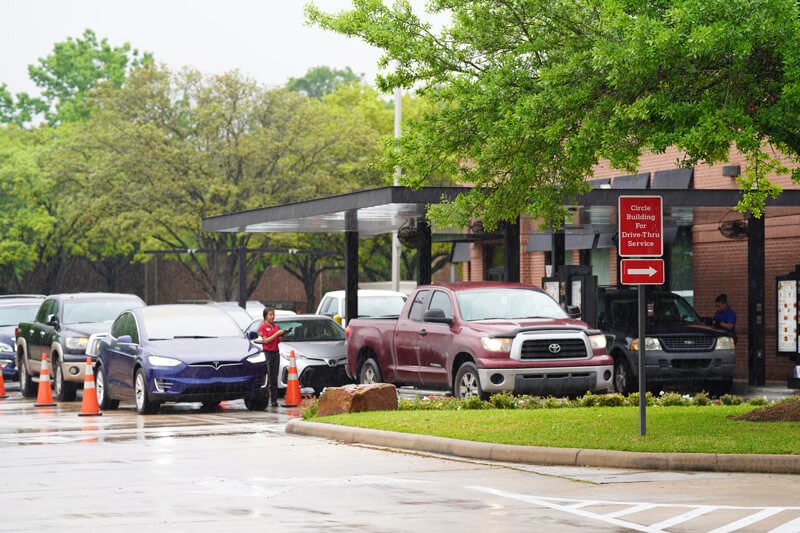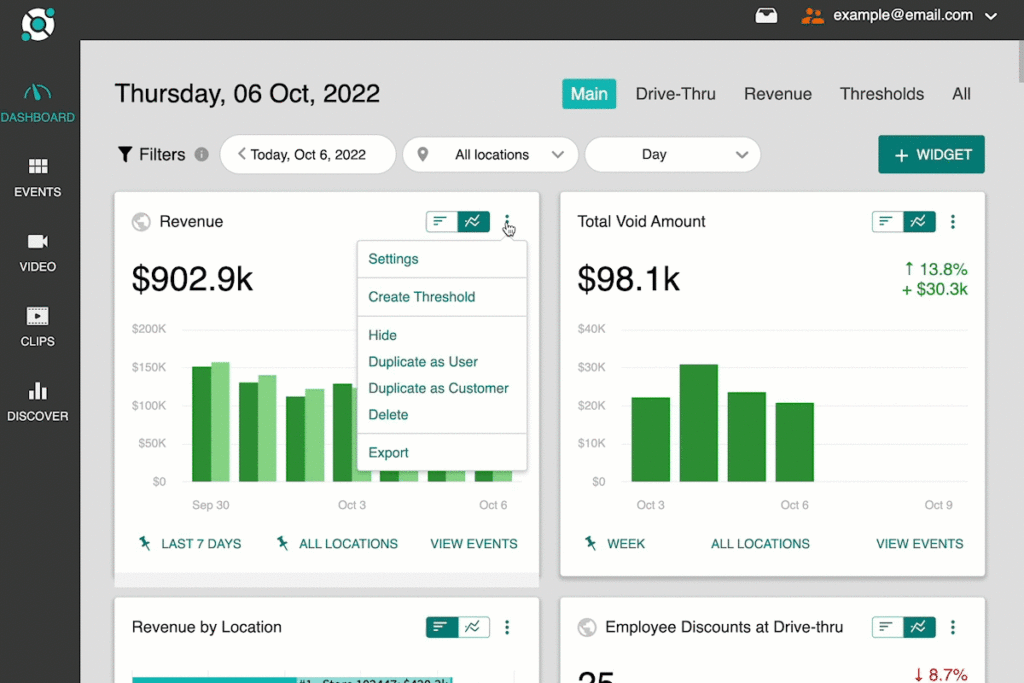Drive-thrus often produce an outsized share of the revenue at quick service restaurants (QSRs) and cafes compared to other point of sale (POS) systems. The customers going through drive-thrus also tend to be in a hurry, so drive thru speed of service is critical. Delays can have bigger repercussions for customer loyalty. Furthermore, order accuracy is a bigger issue if errors aren’t found before the customer drives away. That’s why so many restaurants monitor drive thru speed of service, accuracy, and customer engagement with drive-thru timers.
However, there’s a better way to monitor your key drive-thru metrics, including drive thru speed of service. Here’s how video security can completely replace your drive-thru timer system. Solink can also help you monitor and improve many other key metrics with our drive-thru analytics.
See what makes Solink key technology for driving profit at QSRs.
Here’s a simple drive-thru analytics definition:
Drive-thru analytics, sometimes called drive-thru video analytics, is the use of tools such as drive-thru timers and video security to analyze traffic through your drive-thru. This provides insights into how your business is doing, for example your drive-thru speed of service, accuracy, and customer engagement. By understanding these key metrics, you can bring greater profitability to your drive-thrus.
Drive-thru industry statistics
CNBC recently reported that McDonald’s and Arby’s had the most accurate drive-thrus, with 89% of customers surveyed saying their orders were correctly filled. Burger King came in third place at 87%, while Wendy’s finished last with a 79% drive-thru order accuracy rate.
Similarly, CBS reported that Chick-fil-A had the slowest drive-thru. Conversely, Taco Bell was the fastest at 221 seconds of total service time, followed by Dunkin’ Donuts, KFC, and Arby’s.
However, Chick-fil-A also had the longest drive-thru lines. When accounting for this, they actually had the fastest drive-thru speed of service at 107 seconds per car. McDonald’s came in second at 118 seconds, followed by Taco Bell and KFC.
Much of this information can be found in the 22nd Annual Drive-Thru Study released by Intouch Insight in partnership with QSR Magazine. For the last 22 years, they have combined to perform first-hand research on the drive-thrus of Arby’s, Burger King, Carl’s Jr, Chick-fil-A, Dunkin’ Donuts, Hardee’s, KFC, McDonald’s, Taco Bell, and Wendy’s. This information gives franchisees the ability to benchmark their performance against their brand peers and the wider QSR industry.

What are the main drive-thru metrics?
Different QSRs consider a different set of metrics when evaluating their drive-thrus. The following sections outline all of the drive-thru metrics measured in the latest Drive-Thru Study as well as several others tracked by Solink customers.
Drive-thru speed of service
The most important factor in driving profitability at QSR drive-thrus is the number of cars that can be served per hour. Since QSRs experience rushes and lulls, they need to get as many cars as possible through the drive-thru during those busy periods, for example early morning for coffee shops and lunch and dinner for burger and fried chicken restaurants.
Furthermore, reducing wait times in the drive-thru has a greater impact on customer satisfaction than in the restaurant as customers have higher expectations on the speed of service through the drive-thru.
- Wait time: The time a customer waits in the line before their order is taken.
- Service time: The time it takes the customer to order their food and then receive it.
- Window dwell time: The average time a car spends at the payment and/or pickup windows, depending on whether the QSR uses a one- or two-window drive-thru setup.
- Total time: The total time the customer waits in the drive-thru, from when they enter the line to exit with their food.
- Number of cars in line: The number of cars in line, across all stations and lanes, when a customer enters the drive-thru line
- Average total time by cars: The average total time spent in the drive-thru divided by the average number of cars in line.
- Number of cars served per hour: The number of cars served in a given one-hour period, usually benchmarked to the same period the previous week.
To see how Solink can help you get two more cars through your drive-thru during rush periods, sign up for a demo today.
Drive-thru accuracy
Order accuracy is extremely important for customer satisfaction. It also decreases the average cost per order as it reduces wasted food.
Improved drive-thru accuracy can lead to a faster drive-thru as well by requiring fewer reworks. Indeed, your QSR drive-thru gaining a reputation of messing up orders will lead to more customers checking their bags for accuracy before exiting the drive-thru.
- Order accuracy: The percentage of customers answering “yes” when asked if their order was filled correctly.
Drive-thru customer engagement
Effective customer engagement has short-term and long-term impacts on profitability. By following upsell scripts, your employees can increase the average bill. In addition, by being friendly and helpful, employees create a positive impression, leading to greater customer loyalty.
- Suggestive selling: The practice of intentionally upselling customers before or after a customer begins making their order.
- Satisfaction with the level of service: The percentage of customers answering “satisfied” when asked if they were satisfied or not satisfied with their experience.
- Friendliness: How friendly customers rate their service, usually on a three-point scale of “friendly,” “neutral,” or “not friendly.”
How do you measure drive-thru speed of service?
Until recently, a drive-thru timer was the only way to monitor your speed of service. Now, video security can also perform drive-thru analytics. Furthermore, video and audio security combined can help you monitor even more drive-thru metrics without the added hardware and software costs of a drive-thru timer.
Here are the two ways you can measure drive-thru speed of service, accuracy, and customer engagement.
Drive-thru timer
Here’s a basic definition of a drive-thru timer:
Drive-thru timers can be expensive, hard to operate systems, but for many years they were the only way to monitor drive-thru metrics. Now, you can use your video security to perform drive-thru analytics.
Drive-thru video security system
Did you know that the security cameras you already have pointed at your drive-thru for enhanced security and reduced liability can also be used to measure the efficiency of your drive-thru?
Solink provides drive-thru insights by analyzing your video security footage. In addition to being able to measure all the drive-thru metrics above, Solink can perform license plate recognition.
Furthermore, if recording audio is also legal in your jurisdiction, then you can listen in to conversations between your customers and employees to monitor for friendliness, satisfaction, and suggestive selling.
How do you improve your drive-thru speed of service?
The best way to improve your drive-thru speed of service, accuracy, and customer engagement is to measure and benchmark the results. By knowing how all of your drive-thrus are doing today, as well as those of other franchise operators, you can begin to see where you have issues.
Drive-thru video security gives you the ability to see not just that there are issues but why. Since you can peer into individual transactions to see what is causing delays, you are able to quickly resolve issues before they get out of control.
Indeed, real-time monitoring of your drive-thrus allows you to better maintain a high speed of service. For example, Threshold Notifications gives you the ability to set limits on all of your core drive-thru metrics. Then, when one of your drive-thrus is outside your comfort zone, you receive an SMS or email alert. That way you can react in real time to resolve the issue.

Solink is the best way to perform drive-thru video analytics
Solink pairs your drive-thru speed of service data with video footage of each transaction. This goes beyond standard drive-thru timers by not just giving you information about what is happening but real insight into why as well. That way you can resolve issues faster before things get out of control.
To see how Solink can get more cars through your drive-thru, sign up for a demo today.

Solink stands at the forefront of security solutions, excelling in loss prevention and asset protection for businesses. Our content is rich in industry expertise and crafted to provide actionable insights and innovative strategies. We empower businesses to enhance their security systems, optimize operations, and protect their assets more effectively. Discover how our advanced cloud video management system can transform your security approach.
